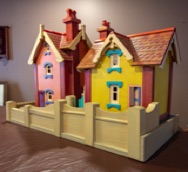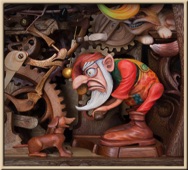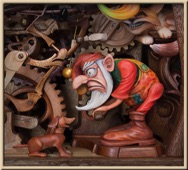Although I am barely average in mechanical ability and find the understanding of mechanical movements challenging. Mechanical movements in action, hold a particular fascination for me, they are something I find particularly engaging. I don’t really understand mechanical things, but I like the look of them. Especially when they are in action.
I suspect this is why so many of us are attracted to steampunk themes in our time. We live in a time when the machinations of our devices are thorough mysteries, hidden under sealed, seamless coverings, thoroughly concealed, out-of-bounds, with ‘no user serviceable parts inside’. Our machines ask for our trust not our interest.
Fortunately when designing automata, the mechanically challenged can make an assemblage from, long ago invented, mechanical movements. They can then link those mechanical movements into a performing group of moving objects, capable of holding an audience's fascination and also engage their desire for, something interesting, that looks good at the same time.
Not an actual useful machine with a useful purpose, such as a real engineer might design, but simply an object, interesting to look at and also one that makes you wonder. With a pretended purpose, insinuated by certain representational elements and characters added on, you now have something that seems clever to those who assume it is clever, and something humorous in a tongue-in-cheek manner, to those who know it isn't.
This is the approach I have taken with my Whimsicalwood Automata which is displayed and described on the About Automata Page.
The toys featured here have also required carving and graphic techniques in their making. Shaping, carving and some graphic work, by way of texturing and painting are particularly evident in the making of the ‘Castle Doll’s House’. I haven’t kept any WIP photos, working drawings or such for the toys shown here, but I do intend to repeat the Castle Doll’s House with working drawings and patterns, step-by-step construction and finishing instructions sometime in the future.
Building the Casle Doll's House from prepared plans, patterns and instructions would be a time consuming project to undertake, but none of the techniques, including the carving, would be too difficult for someone of average ability to manage, given some patterns and instruction to follow.
It will be a mammoth task to draw up formal plans and patterns for this project, which was originally designed as a rough pencil sketch and then as a rough small scale model to be finally constructed full size, piece by piece, intuitively, with some trial and a lot of remedied error.
Some good plans, patterns and instructions will make everything repeatable and predictable once the task is done.F
Automata and toys


